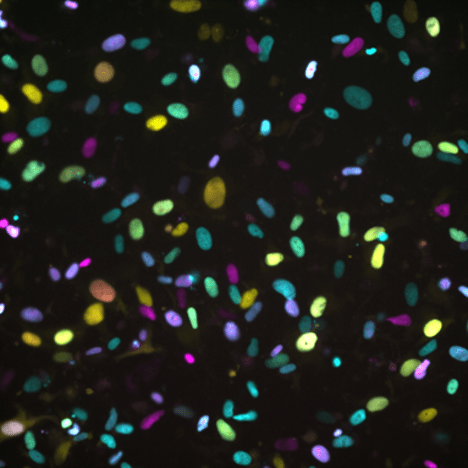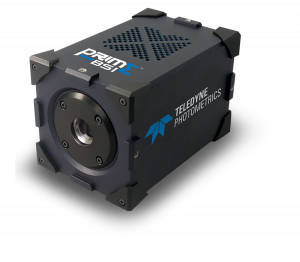Live Cell Time Lapse Imaging
Prof. Kurt Anderson, Dr. Matt Renshaw
Crick Advanced Light Microscopy (CALM), Francis Crick Institute, London
Background
Prof. Anderson is the head of the Crick Advanced Light Microscopy (CALM) facility. Prof. Anderson and senior laboratory research scientist Dr. Matt Renshaw oversee over 16 advanced microscopy systems in the CALM facility, including point scanning confocal, spinning disk confocal, multi-photon, light-sheet, TIRF, and more. CALM staff also train scientists to use these specific systems so they can better obtain quantitative imaging data for their experiments, running microscope courses frequently throughout the year.
One of these imaging systems is used for long-term time-lapse (LTTL) imaging of live cells, a microscope in a closed controlled environment system designed for up to 48 hour experiments on live samples. Researchers from all over the Crick Institute use the LTTL system for cell documentation.

Figure 1: Live cells expressing a FUCCI cell cycle sensor in order to visualize the life
cycle of each cell. The image is a single time point from a longer time-lapse, taken
with the Prime BSI by Jingkun Zeng of the Diffley Lab, Francis Crick Institute.
Challenge
Long term (up to 48 hours) time lapse imaging benefits from a large field of view (FOV) in order to capture as many cells as possible, often taken at low magnifications in order to capture as much data as possible with each frame. By decreasing the magnification, image resolution can be affected. In addition, sensitivity is vital in order to capture quantitative data from cell populations across these long term experiments.
In general, the challenge is that users of the LTTL system want a big field of view in order to track as many cells as possible over the long term, in order to look at mitosis and other cell behavior, while retaining sensitivity, speed, and resolution at these lower magnifications.
By changing to the Prime BSI, it allowed users to reduce the magnification from 60 to 40 or 20, letting them take images with a much larger FOV without a loss of sensitivity
Prof. Kurt Anderson , Dr. Matt Renshaw
Solution
The large FOV and high resolution of the Prime BSI is a good fit for the LTTL system compared to previous CCD or EMCCD solutions.
As the majority of live cell experiments involve samples that are sensitive to light, users can make the most of the high sensitivity of the BSI and drop the exposure and light intensity, decrease the bit depth to 12 bit (increasing the imaging speed) and work in low-light conditions. As mentioned by Dr. Renshaw, "we originally had a CCD solution, the smaller sensor would only capture a quarter of the FOV as the sCMOS, so would need four times the images and exposures to capture the same number of cells." The CALM facility has access to a number of scientific camera solutions, with Dr. Renshaw also saying "we had a EMCCD with very big pixels, by changing to the Prime BSI with smaller pixels, it allowed users to reduce the magnification from 60 to 40 or 20, letting them take images with a much larger FOV without a loss of sensitivity".
Learn More About The Prime BSI